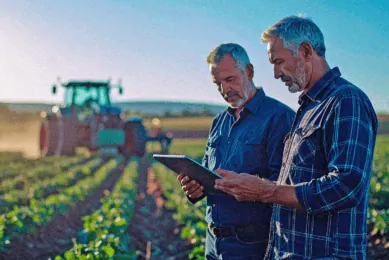Data sharing key for AI in agriculture

Farmers must keep in mind that companies that develop algorithms depend on their data. That is why data sharing is so important, states the Agricultural Data Coalition.
Companies that develop Artificial Intelligence (AI) depend heavily on data from farmers for their machine learning algorithms. Tremendous amounts of data are needed to train these systems. “Otherwise a companies product could be less accurate than the system of a competitor with more data. This also shows why some people have been describing data as a new form of currency,” states the Agricultural Data Coalition (ADC) in an article on their website.
Monetary value
Data gathered and provided by farmers is very valuable and important to train algorithms. At the same time it’s difficult to quantify the monetary value of any particular set of data fed into the system. “Individually the data records have little value, their true significance comes though when combined with many other records,” says the ADC.
Text continues underneath image
Therefore, the Agricultural Data Coalition says, “it is important all parties know what is going on, who needs what data, what they are doing with it, and what benefits each party receives from sharing it. This is an exciting time to be involved with agriculture and AI will undoubtedly have a substantial impact on how farming is done for years to come.”
How can Artificial Intelligence make a seeding recommendation?
It takes a lot of data to train the algorithms, but what are they being trained for in this instance?The idea is that in a certain soil type, with a certain weather pattern, and as many other variables as can be accounted for, seed variety X will have yield Y. If you have a big enough database of information, you can train the computer system to determine what the “best” variety is for a field. The system is essentially trained to look through all the data and find field conditions that are a doppelganger or look just like the field being asked about. Digging through (commonly called data mining) all this data allows the AI to make the determination variety XYZ is the best for this field since there is data from a bunch of other parts of different fields that have the same or similar conditions where that variety yielded better than other varieties grown in those conditions.
While Artificial Intelligence holds great promises for use in agriculture, these products have yet to take over the market. Why? According to the ADC, one hurdle is having enough data available. “If you are trying to match up all the different variables for a field you need a lot of different combinations of soil types, weather, seed, fertility, planning dates, etc.”
Text continues underneath image
Data accuracy a hurdle
Another thing is the data needs to be somehow standardised and read into a system. And most important, data needs to be accurate: “As an industry this is something we struggle with. Think of a yield file from a combine. Often you’re lucky if the correct crop type was captured in the data and the yield sensor was calibrated this season,” says the ADC.
Also read: Data ownership questions – and why they’re important
“Most people in precision ag have seen fields of 250-bushel yields in “soybean” fields where the operator didn’t bother to label it as corn. For the AI system to be able to recommend a variety we not only need the correct crop type documented but we also need to know what variety was actually planted, when, and at what population to really be able to train the algorithms and mine the data.”
Text continues underneath image
Amount of variables
A third obstacle according to the ADC is the amount of variables to account for in farming.“Most obvious is weather. It isn’t too hard to have a record of what happened in a field from a weather standpoint. However, knowing what the coming season is going to look like is a little trickier.”
That means that you not only need to have all the different data about when, how, where, and which seed was planted, you also need to know if it is going to be a hot dry year, or cool and wet, says the ADC.
Forecast accuracy
Luckily, forecasts are continually improving. “Largely from the application of the same type of AI systems to model weather to know what is coming. However forecast accuracy is really only something you can really trust out a few days, or maybe a week or 2. Knowing what the next 6 months are going to be like is still fairly hard to predict for the most part, but again things are always getting better as the machines learn more.”
Other applications for machine learning
- Automated machine adjustments (combine, planter down force, etc.)
- Weather forecasting
- Disease or pest identification, image recognition
- Disease and pest movement
- Machine maintenance and break-down prediction
- Field accessibility or harvest advisory type estimations
- Irrigation and water management
- Nutrient use and fertility recommendations
- Autonomous machines or robots
Join 17,000+ subscribers
Subscribe to our newsletter to stay updated about all the need-to-know content in the agricultural sector, two times a week.



